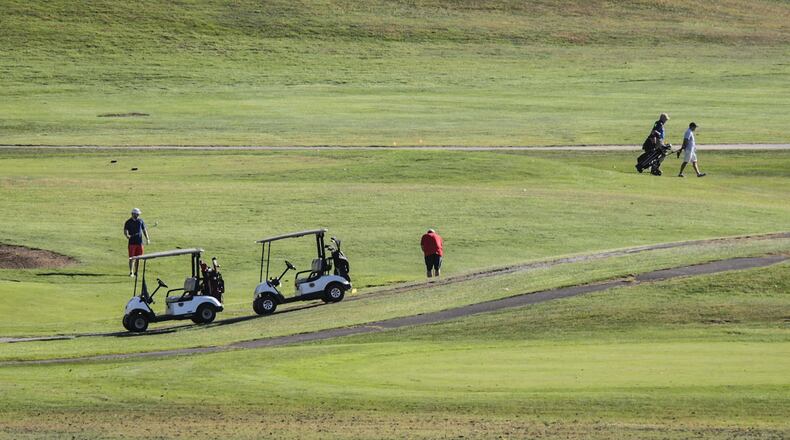Dayton’s Community Golf Course, which reopened later than most May 15, surpassed target revenues and had a “very busy year,” one official said.
It’s part of a national trend Miami Valley Golf Association Executive Director Steve Jurick said he expects to continue next year because of the uncertainty of the coronavirus.
“Everybody and their brother who has ever played golf is playing golf,” Jurick said. “And then we’ve got a decent number of new golfers and returning golfers. It’s replacing a lot of the quasi-entertainment/health dynamics.”
COVID has caused some other forms of entertainment and recreation to become off-limits. Golf has marketed itself as having built-in social distancing - players can check-in remotely and walk straight to the first tee. There has also been good weather through the summer and fewer courses with the city of Dayton permanently closing two of its three golf complexes - Kittyhawk Golf Center and Madden Golf Course.
“Unfortunately, (COVID-19) has affected so many, many, many people in so many different ways. But our golf facilities have been able to provide that respite in the storm,” Jurick said.
“And because of that, they’re having – I wouldn’t say record rounds – I would say record rounds for the last 20 years,” he added.
“Busiest golf-wise in several years”
Courses like Beavercreek Golf Club, Heatherwoode Golf Club, Mound Golf Course, Pipestone Golf Club, The Golf Club at Yankee Trace and others were aided by a wave that saw record-shattering summer months for the industry, officials said.
More than than half of the U.S. golf courses closed by May 5 due to COVID-19, but 98% reopened by early June. That was followed, according to the National Golf Foundation, by “spectacular summer” weather for much of the country’s Midwest and Northeast and local courses said they benefitted.
Nationally, the conditions led to record numbers in July and August, prompting play to be 6% ahead of the 2019 pace entering the final months of the year, the foundation said on its website.
Through Oct. 1, Springboro’s Heatherwoode rounds and revenues were up 15% percent over last year, General Manager Tom West said.
Business at the Beavercreek Golf Club is up 15-20% with 2,500 more rounds this year over last year, said Joe Moore, PGA head golf pro there.
At the 36-hole Community Golf Course owned by the city of Dayton, through Sept. 30 the course topped its average revenue for the past six years by $50,000 and 93% of rounds were played after the May 15 reopening, according to Kelly Pressel, city golf division manager.
With the closings of Kittyhawk and Madden, “naturally, there is going to be an increase in play” at Community, Pressel said in an email.
Numbers at Mound and Pipestone in Miamisburg are also up, prompting that city’s recreation director, Ryan Davis, to call 2020 “definitely the busiest golf-wise in several years.”
At Pipestone, “this year in golf has been like no other,” General Manager Jay Caligiuri said in an email. “Staff believes one reason for the increase in business this year is that people are working from home and have more free time to get out during the day,” he added.
Dayton closing courses
The activity at the 27-hole Yankee Trace may well shatter previous marks that have come at time when it has seen “enormous growth in both rounds and revenues for several years,” PGA head pro Steve Marino said in an email.
“The circumstances resulting from COVID-19 created a large demand for outdoor activities and many people discovered what regular golfers already knew: The game of golf not only offers physical benefits but mindful rest from the worries of the world,” Marino added.
Messages for this article were also left with Vandalia, which operates the Cassel Hills Golf Course, but were not returned.
Dayton’s decision after the coronavirus outbreak this spring to close Kittyhawk and Madden sent more golfers to other golf courses, officials said.
Both Kittyhawk, open since the early 1960s, and the 91-year-old Madden were considered a financial drain on Dayton’s budget as projections loomed about lost tax revenue due to COVID-19 shutdowns, city officials said.
Large gathering losses
COVID-19 hurt other parts of the operations of some courses. Yankee Trace’s Marino said “every aspect of our business has been affected.”
In the spring, courses required golfing partners to ride in separate carts and limited contact with and between patrons. Courses restricted golfers from handling commonly touched items - such as flagsticks – and some limited food service to curtail contact.
Yankee Trace shut down its restaurant for a few weeks in August after one employee there tested positive for the virus.
Large gatherings such as wedding receptions and graduation parties – a staple for many clubhouse operations – were cancelled.
At Pipestone, 23 graduation parties and 55 golf outings were called off, according to Caligiuri. The scratched golf outings alone account for an estimated $80,000-$90,000 in lost revenue from food and beverage sales, he said.
Beavercreek’s Moore, too, noted, “a negative impact to our food portion of the business.”
Still, Marino said, golf courses have remained open at a time when many businesses have faced long-term government shutdowns.
“We feel very thankful” Ohio Gov. Mike DeWine and health officials “believed in the positive benefits of golf and how the game could be helpful for the community during the pandemic,” he said. “They have monitored our industry throughout the pandemic to assure that we live up to the health and safety guidelines set forth.”
GOLF IN 2020
The following includes play at city-owned area golf courses through Oct. 1.
Course Total rounds Green fee revenue
•Beavercreek, 24,921 $492,376
•Community,* 63,640 $775,200
•Heatherwoode, 33,715 $706,171
•Mound,** 18,418 $168,158
•Pipestone, 32,542 $683,688
•Yankee Trace,*** 56,000 $1.4 million
* Community has 36 holes
** Mound has nine holes.
** Yankee Trace has 27 holes.
SOURCES: The cities of Beavercreek, Centerville, Dayton, Miamisburg and Springboro.
BY THE NUMBERS
•441M: Rounds played on U.S. golf courses in 2019.
•24.3M: Americans age 6 or older who played golf in 2019.
•98: Percentage of U.S. golf courses open by June 7.
•44: Percentage of U.S. golf courses open by April 5.
SOURCES: The National Golf Foundation and the city of Dayton.
About the Author

